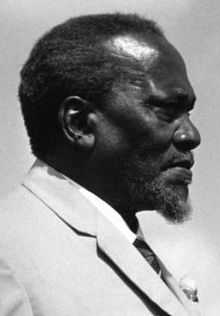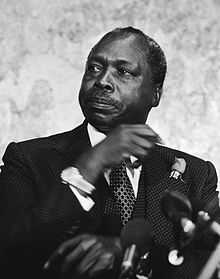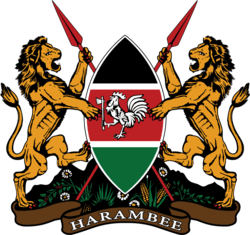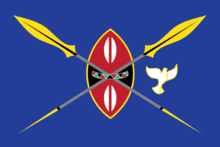President of Kenya
| President of the Republic of Kenya | |
|---|---|
|
Coat of arms of Kenya | |
|
Presidential Standard | |
| Style |
His Excellency (formal) |
| Residence | State House, Nairobi (Official Residence) |
| Appointer | Direct popular vote |
| Term length |
Five years renewable once |
| Inaugural holder |
Jomo Kenyatta 12 December 1964 |
| Salary |
KES.14.4 million (US$ 132,000) annually[1] |
| Website | president.go.ke |
The President of the Republic of Kenya (Swahili: Rais wa Jamhuri ya Kenya) is the head of state and head of government of Kenya. The president leads the executive branch of the Government of Kenya and is the commander-in-chief of the Kenya Defence Forces. The official residence of the president is at State House, Nairobi. The wife of the President is referred to as the First Lady of Kenya.
Presidents
Kenya has had four presidents, namely:
- Jomo Kenyatta: 12 December 1964 - 22 August 1978
- Daniel Toroitich arap Moi: 22 August 1978 - 30 December 2002
- Mwai Kibaki: 30 December 2002 - 9 April 2013
- Uhuru Kenyatta: 9 April 2013 – Present
Two of Kenya's presidents had also been vice-presidents before, with Daniel Toroitich arap Moi serving as Jomo Kenyatta's third and final vice-president before his death, and Mwai Kibaki serving as Moi's first and Kenya's fourth vice president.
Jomo Kenyatta led Kenya from independence in 1963 to his death in 1978, serving first as Prime Minister (1963–64) and then as President (1964–78). He is considered the founding father of the Kenyan nation. During Kenyatta's presidency, Kenya joined the United Nations and the Organization for African Unity. He was also instrumental in the formation of the first East African Community.
Daniel Toroitich Arap Moi is the longest serving president, serving for a total of 24 years, starting in 1978 after the death of Jomo Kenyatta, to 2002, when he stepped down following a constitutionally imposed term limit. During that time Kenya's economy faced severe stagnation and decline, partly due to massive corruption. The first multi-party elections since independence were held in 1992, and the President was elected by popular vote for the first time. This followed changes in the constitution that ended de facto one-party rule by the Kenya African National Union. Moi won in 1992 and 1997, beating contenders that included Jaramogi Oginga Odinga and Kenneth Matiba. During Moi's presidency, Kenya joined COMESA, IGAD and the Group of 15.
Mwai Kibaki won the presidential elections in 2002 that followed Moi's resignation, and presided over a period of economic recovery following the stagnation of the Moi years. Additionally, during Kibaki's term, measures such as the Kenya Economic Stimulus Program and the Constituency Development Fund were instituted to spur grassroots development through distributing and devolving the management of Government funds. A dispute over the results of the 2007 presidential election led to the 2007–2008 Kenyan crisis during which over 1000 Kenyans died. In an arrangement to bring an end to the violence, a grand coalition government was set up, with Kibaki as president, and Raila Odinga as Prime Minister, the first since 1964 after Jomo Kenyatta, who served as Prime Minister when Kenya was a monarchy under Queen Elizabeth II, became president.
In 2013, Uhuru Kenyatta, son of first president Jomo Kenyatta, was elected president, presiding over a system that has changed from a strong central government with eight provinces to a more devolved one consisting of forty-seven counties. This election was notable, since Uhuru Kenyatta has been indicted by the International Criminal Court in connection with the 2007–2008 Kenyan crisis following the 2007 general election.
Presidential terms
Under the 1964 constitution of the Republic of Kenya, the President replaced the monarch as executive head of state. The President was elected by Parliament for a five-year term. In the event of a vacancy the Deputy President served as Acting President.
- Parties
Kenya African National Union
National Rainbow Coalition / Party of National Unity
Jubilee Alliance
| № | Portrait | Name | Term | Tenure | Election Year/Voter Percentage | Affiliation | |
|---|---|---|---|---|---|---|---|
| 1 |  |
Jomo Kenyatta (1893–1978) |
1 | 12 December 1964 |
6 December 1969 |
1964 — |
Kenya African National Union |
| 2 | 6 December 1969 |
14 October 1974 |
1969 — Unopposed | ||||
| 3 | 14 October 1974 |
22 August 1978† |
1974 — Unopposed | ||||
| The first President of the Republic of Kenya, he was also one of two of the only serving Prime Ministers of Kenya. Kenya was a one-party state until the Kenyan presidential election, 1992. There were also never any Presidential elections during his presidency. †Died in office while on tour in Mombasa in August, 1978. | |||||||
| During this interval, Vice-President Daniel Arap Moi was the Acting President. | |||||||
| 2 |  |
Daniel Arap Moi (1924– ) |
4 | 8 November 1979 |
26 September 1983 |
1979 — Unopposed [2] | Kenya African National Union |
| 5 | 26 September 1983 |
21 March 1988 |
1983 — Unopposed [3] | ||||
| 6 | 21 March 1988 |
29 December 1992 |
1988 — Unopposed [4] | ||||
| Vice-President under Jomo Kenyatta, Daniel arap Moi succeeded him on his death. He served at a time during which Kenya was a one-party state, and he ran unopposed for the 1979, 1983 and the 1988 Kenyan elections. | |||||||
| First Multi-Party Elections Held in 1992 | |||||||
| (2) |  |
Daniel Arap Moi (1924– ) |
7 | 29 December 1992 |
29 December 1997 |
1992 — 36.4% 1,962,866 |
Kenya African National Union |
| 8 | 29 December 1997 |
29 December 2002 |
1997 — 40.6% 2,500,856 | ||||
| Daniel arap Moi became the longest serving president,after serving for 24 years. He stepped down after serving two 5-year terms in 2002, after the constitution was drafted to limit the terms one could serve as President of Kenya. | |||||||
| 3 |  |
Mwai Kibaki (1931– ) |
9 | 29 December 2002 |
29 December 2007 |
2002 — 61.3% 3,647,658 |
National Rainbow Coalition (2002–2007) |
| 10 | 30 December 2007 |
3 April 2013 |
2007 — 47% 4,584,721 |
Party of National Unity (2007–2013) | |||
| When Mwai Kibaki took office Kenya's economy was doing poorly, under his government by 2007 the economy had an average growth rate of 7.1%. Kibaki introduced the Kenya Vision 2030 Programme, an economic blueprint designed to steer Kenya into a middle income nation by 2030. | |||||||
| 4 |  |
Uhuru Kenyatta (1961– ) |
11 | 4 April 2013 |
Incumbent | 2013 — 50.07% 6,158,610 |
Jubilee Alliance |
| The son of former President Jomo Kenyatta. First President of a devolved Kenyan system. | |||||||
See also
 |
| This article is part of a series on the politics and government of Kenya |
|
Constitution |
|
Legislature
|
|
|
Administrative divisions |
|
|
| Foreign relations |
|
Economic schemes |
|
Politics portal |
- Politics of Kenya
- List of colonial governors of Kenya
- Governor-General of Kenya
- List of Presidents of Kenya
- Prime Minister of Kenya
- Lists of Incumbents
References
- ↑ Nsehe, Mfonobong (2014-03-09). "Kenya's Wealthy President Uhuru Kenyatta To Take Pay Cut". Forbes. Retrieved 18 December 2014.
- ↑ http://www.aaregistry.org/historic_events/view/kenya-achieves-independence
- ↑ http://www.aaregistry.org/historic_events/view/kenya-achieves-independence
- ↑ http://www.aaregistry.org/historic_events/view/kenya-achieves-independence
| ||||||||||||||
